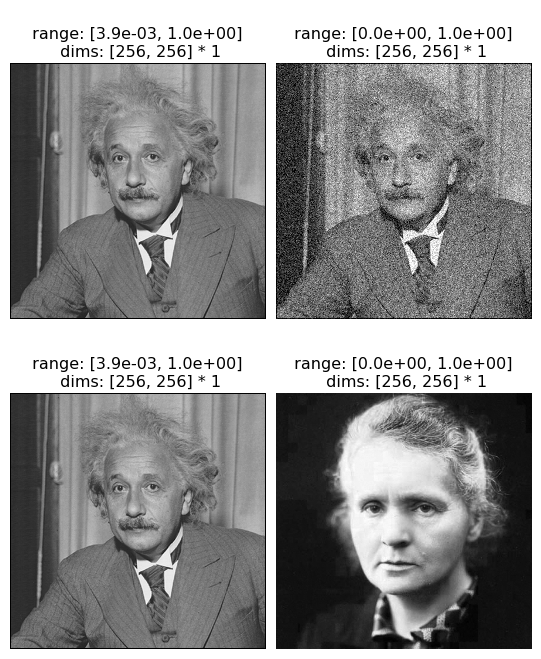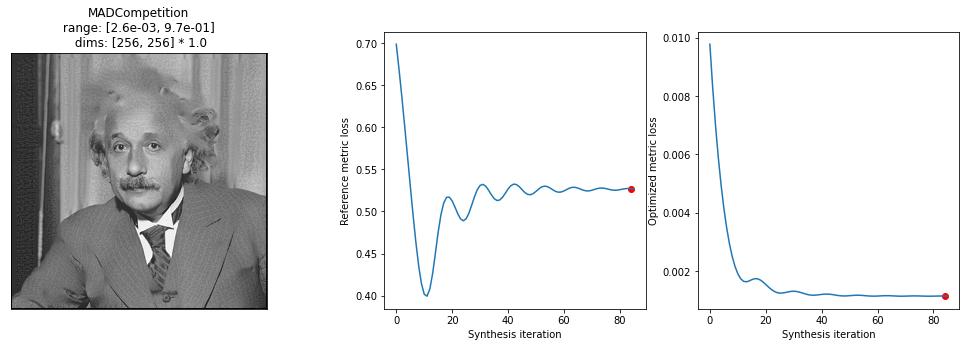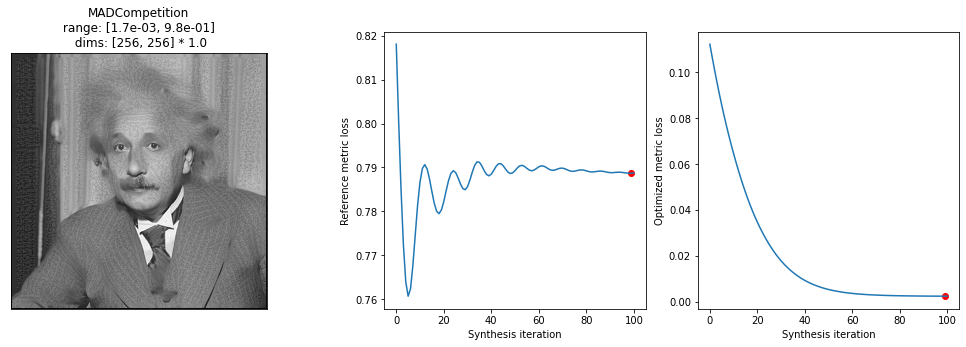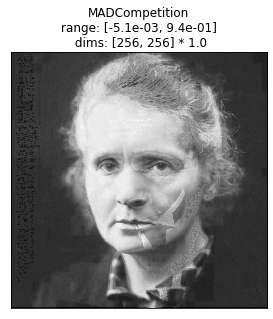Extending existing synthesis objects
Once you are familiar with the existing synthesis objects included in plenoptic, you may wish to change some aspect of their function. For example, you may wish to change how the po.synth.MADCompetition initializes the MAD image or alter the objective function of po.synth.Metamer. While you could certainly start from scratch or copy the source code of the object and alter them directly, an easier way to do so is to create a new sub-class: an object that inherits the synthesis object
you wish to modify and over-writes some of its existing methods.
For example, you could create a version of po.synth.MADCompetition that starts with a different natural image (rather than with image argument plus normally-distributed noise) by creating the following object:
[1]:
import plenoptic as po
from torch import Tensor
import torch
import matplotlib.pyplot as plt
import warnings
from typing import Union, Callable, Tuple, Optional
from typing_extensions import Literal
# so that relative sizes of axes created by po.imshow and others look right
plt.rcParams['figure.dpi'] = 72
%load_ext autoreload
%autoreload 2
[2]:
class MADCompetitionVariant(po.synth.MADCompetition):
"""Initialize MADCompetition with an image instead!"""
def __init__(self, image: Tensor,
optimized_metric: Union[torch.nn.Module, Callable[[Tensor, Tensor], Tensor]],
reference_metric: Union[torch.nn.Module, Callable[[Tensor, Tensor], Tensor]],
minmax: Literal['min', 'max'],
initial_image: Tensor = None,
metric_tradeoff_lambda: Optional[float] = None,
range_penalty_lambda: float = .1,
allowed_range: Tuple[float, float] = (0, 1)):
if initial_image is None:
initial_image = torch.rand_like(image)
super().__init__(image, optimized_metric, reference_metric,
minmax, initial_image, metric_tradeoff_lambda,
range_penalty_lambda, allowed_range)
def _initialize(self, initial_image: Tensor):
mad_image = initial_image.clamp(*self.allowed_range)
self._initial_image = mad_image.clone()
mad_image.requires_grad_()
self._mad_image = mad_image
self._reference_metric_target = self.reference_metric(self.image,
self.mad_image).item()
self._reference_metric_loss.append(self._reference_metric_target)
self._optimized_metric_loss.append(self.optimized_metric(self.image,
self.mad_image).item())
We can then interact with this new object in the same way as the original MADCompetition object, the only difference being how it’s initialized:
[3]:
image = po.data.einstein()
curie = po.data.curie()
new_mad = MADCompetitionVariant(image, po.metric.mse, lambda *args: 1-po.metric.ssim(*args),
'min', curie)
old_mad = po.synth.MADCompetition(image, po.metric.mse, lambda *args: 1-po.metric.ssim(*args),
'min', .1)
/home/billbrod/Documents/plenoptic/plenoptic/tools/data.py:126: UserWarning: Creating a tensor from a list of numpy.ndarrays is extremely slow. Please consider converting the list to a single numpy.ndarray with numpy.array() before converting to a tensor. (Triggered internally at ../torch/csrc/utils/tensor_new.cpp:230.)
images = torch.tensor(images, dtype=torch.float32)
/home/billbrod/miniconda3/envs/plenoptic/lib/python3.9/site-packages/torch/functional.py:504: UserWarning: torch.meshgrid: in an upcoming release, it will be required to pass the indexing argument. (Triggered internally at ../aten/src/ATen/native/TensorShape.cpp:3190.)
return _VF.meshgrid(tensors, **kwargs) # type: ignore[attr-defined]
/home/billbrod/Documents/plenoptic/plenoptic/synthesize/mad_competition.py:130: UserWarning: To copy construct from a tensor, it is recommended to use sourceTensor.clone().detach() or sourceTensor.clone().detach().requires_grad_(True), rather than torch.tensor(sourceTensor).
loss_ratio = torch.tensor(self.optimized_metric_loss[-1] / self.reference_metric_loss[-1],
/home/billbrod/Documents/plenoptic/plenoptic/synthesize/mad_competition.py:134: UserWarning: Since metric_tradeoff_lamda was None, automatically set to 0.10000000149011612 to roughly balance metrics.
warnings.warn("Since metric_tradeoff_lamda was None, automatically set"
/home/billbrod/Documents/plenoptic/plenoptic/synthesize/mad_competition.py:134: UserWarning: Since metric_tradeoff_lamda was None, automatically set to 0.009999999776482582 to roughly balance metrics.
warnings.warn("Since metric_tradeoff_lamda was None, automatically set"
We can see below that the two versions have the same image whose representation they’re trying to match, but very different initial images.
[4]:
po.imshow([old_mad.image, old_mad.initial_image, new_mad.image, new_mad.initial_image],
col_wrap=2);

We call synthesize in the same way and can even make use of the original plot_synthesis_status function to see what synthesis looks like
[5]:
with warnings.catch_warnings():
# we suppress the warning telling us that our image falls outside of the (0, 1) range,
# which will happen briefly during synthesis.
warnings.simplefilter('ignore')
old_mad.synthesize(store_progress=True)
po.synth.mad_competition.plot_synthesis_status(old_mad, included_plots=['display_mad_image', 'plot_loss']);

[6]:
with warnings.catch_warnings():
# we suppress the warning telling us that our image falls outside of the (0, 1) range,
# which will happen briefly during synthesis.
warnings.simplefilter('ignore')
new_mad.synthesize(store_progress=True)
po.synth.mad_competition.plot_synthesis_status(new_mad, included_plots=['display_mad_image', 'plot_loss']);

For version initialized with the image of Marie Curie, let’s also examine the metamer shortly after synthesis started, since the final version doesn’t look that different:
[7]:
po.synth.mad_competition.display_mad_image(new_mad, iteration=10);

See the documentation for more description of how the synthesis objects are structured to get ideas for how else to modify them, but some good methods to over-write include (note that not every object uses each of these methods): _initialize, _check_convergence, and objective_function (for more serious changes to initialization, probably better to start with _initialize). For a more serious change, you could also overwrite synthesis and
_optimizer_step (and possibly _closure) to really change how synthesis works. See po.synth.MetamerCTF for an example of how to do this.